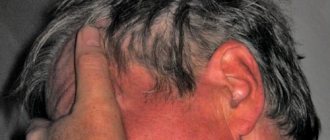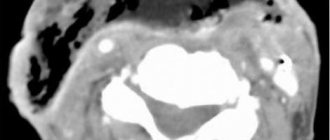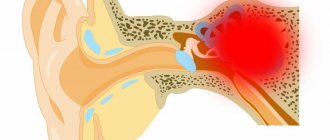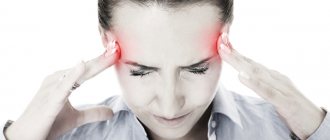Neurosis is the name of a mental state disorder characterized by irritability, outbursts of emotions from intense joy to depression, sudden deterioration in health - these manifestations may indicate the presence of neurosis. It is important to distinguish it from a person’s natural temper, as well as from an anxiety disorder or neurosis-like schizophrenia. Let's look at the symptoms and signs of these pathologies and find out how they differ from each other.
In this article
- Neurosis: symptoms, diagnosis, treatment
- Causes of neuroses
- Signs of neurosis
- Types of neuroses
- Neurosis and schizophrenia: differences between pathologies
- Can neurosis turn into schizophrenia?
- Neurosis-like schizophrenia: main differences from neurosis
- Treatment of neuroses
Neurosis: symptoms, diagnosis, treatment
Neurosis, as noted above, is a mental disorder characterized by destructive behavioral manifestations, hysterical and asthenic reactions against the background of decreased mental and physical performance. Neuroses are not so easy to diagnose; they often have a latent (hidden) course. Neurotics themselves are often unable to detect an anomaly, paying attention to their psycho-emotional state only at critical moments of breakdowns and hysterical attacks. The patient’s relatives also do not notice the abnormalities, since neurotic disorders occur latently, appearing from time to time. Patients often withdraw into themselves and limit their social circle, which also makes it difficult to notice unusual behavior.
Features of pseudoneurotic schizophrenia
Symptoms appear spontaneously without a clear connection with external factors. Over time, manifestations may increase or disappear on their own. The clinical picture is ambiguous, as it may correspond to other diseases. Only a psychiatrist can verify the condition.
Behavior
The intensity of manifestations varies depending on the severity of the disorder in a particular person. Despite individual differences, the behavior of patients may have the following general characteristics:
- Obsessive (obsessive) actions of high strength. People perform their characteristic rituals for a long time, not paying attention to the people around them. For example, washing your hands three times is a prerequisite for leaving the house.
- Removal from society is the autization of personal attitudes. The circle of communication is limited to relatives or single friends. Communication takes place more out of necessity, which does not make patients unhappy.
- Strange manner of speech using abstract phrases.
- Atypical style of clothing. Often simply untidy, indicating complete indifference to the opinions of other people.
- Ignoring conventions, rules of behavior, etiquette.
- Narrowing the range of interests.
- Refusal to eat to the point of anorexia or bizarre dietary habits. For example, a person begins to eat only herbs or raw foods. The motivational reasons for such tricks are illogical - “I want my face to look like a cat’s face.”
- Monotonous asthenia is a neuropsychic weakness that does not improve after rest.
Any anxiety acts as a catalyst for anxiety-phobic syndromes. It becomes difficult for a person to respond adequately in simple social situations. Any changes in psycho-emotional status are reflected in behavior.
Psycho-emotional and neurotic manifestations
Neurosis-like symptoms arise against a persistently altered psychopathological background. During periods of exacerbation the following symptoms are typical:
- daily mood swings for no reason;
- anxiety and restlessness intensify in unfamiliar conditions or crowded places;
- tendency to reflect;
- obsessive doubts and obsessions with contrasting content;
- several different emotions appear together or replace each other too quickly, and their color also changes unpredictably;
- reactions to ordinary stimuli are inconsistent or generally inert;
- feelings of guilt, anger, fear are distorted, but it is extremely difficult to cope with them;
- anhedonia – decreased ability to experience pleasure;
- pronounced insurmountable phobias of strange content, for example, fear of the color red or the letter “O”;
- sensory-emotional experiences can be perceived by a person as a manifestation of weakness, so he tries to refuse them;
- Hypochondria is an excessive concern about one’s health, which manifests itself in the form of fanciful complaints (“bones are crumbling,” “blood flows from one hand to another”).
In severe cases of the disorder, obsessive-phobic experiences reach such strength that some patients begin to show signs of suicidal behavior. The first changes can be noticed in adolescence, since obsessions usually remain the same, but their severity worsens.
FINK Gennady Fishelevich. SLUGGY NEUROSIS-LIKE SCHIZOPHRENIA (CLINICAL-SYSTEM-ANALYTICAL STUDY). Abstract of the dissertation for the degree of Doctor of Medical Sciences
Sensorimotor perception
A person’s perception of his own body changes, usually in a negative way. Among the symptoms, the following changes predominate:
- depersonalization – a violation of a person’s self-perception, in severe cases – a feeling of loss of one’s own “I”;
- dysmorphomania – a painful belief in the presence of physiological defects or deficiencies, reaching the level of delusional disorders;
- pathological belief in (imaginary) ugliness becomes a barrier to social interaction;
- alleged shortcomings and defects are masked with the help of clothing, perfume, and unjustified surgical interventions.
Sluggish schizophrenia tends to progress and transform into a more severe course. In adolescence, such individuals may suffer from eating disorders (bulimia, anorexia) due to an unreasonable disgust for their body.
Thinking
Symptoms are grouped into a single clinical picture, accompanying each other. With a more detailed diagnosis, the doctor also identifies thinking disorders:
- lack of concentration;
- a fine line between the perception of real and fictional;
- inability to hold focused thoughts for a long time;
- a person does not see the difference between thoughts that are similar in emotional color or content;
- weakening of the ability to adequately understand any concepts;
- change in self-perception;
- the constant presence of a “motivating” attitude, which triggers an unstoppable sequence of obsessive thoughts;
- the patient does not recognize antisocial behavior, so their actions often cause confusion among others.
Excessive preoccupation with one's own health or appearance is reflected in thinking, which becomes pathological. At the same time, the patient does not understand the depth of the problem.
Causes of neuroses
Experts believe that the main factor leading to the formation of a neurotic state is psychotrauma of various kinds. This could be a stressful situation at work, an intimate problem, even a psychological trauma that happened in childhood and manifested itself in adulthood.
In childhood, we are in a position of constant imprinting - this is the name given to fixing certain information in memory and depending on it. Many impressions and experiences experienced by a child leave an imprint on his future life.
However, almost every person finds himself in difficult situations, and few people can boast of an absolutely cloudless childhood. Why doesn’t everyone develop neuroses? The fact is that experiences and stress alone do not lead to the development of neurosis. They should lie on the prepared soil. What matters are personality traits, character, and innate temperament.
Some manifestations suggest a neurotic condition, but only a specialist can make a final diagnosis.
Causes
The causes of sluggish schizophrenia are still the subject of research by medical science.
Patients are diagnosed with:
- biochemical disorders of brain neurotransmitters
- hormones that transmit information between neurons: excitation of receptors, excess secretion of dopamine, etc.; - pathologies in the limbic system of the brain:
failure of the functions of the frontocerebellar connections, disruption of the coordinated functioning of the hemispheres.
There was no connection between the occurrence of the disease and the gender of the patient. Statistics show that in men the course of the disease is more severe than in women, that residents of large cities, unprotected social and asocial segments of the population are more susceptible to various forms of sluggish schizophrenia.
Modern scientists consider the main factors in the development of the disease to be:
- genetic predisposition, unfavorable heredity;
- severe stress;
- brain injuries;
- stable unfavorable psychological background in the family, at work, at the place of study;
- past infectious diseases.
Signs of neurosis
The disease manifests itself in completely different ways, but there are also common symptoms:
- increased sensitivity;
- suspiciousness and anxiety;
- sudden change of mood for an unimportant reason;
- depressed mood;
- difficulties in adapting to changed conditions;
- obsessive states.
Rarely, the following factors can lead to the appearance of neurosis:
- infectious diseases of the brain;
- alcoholism, taking psychotropic substances;
- head injuries;
- chronic fatigue;
- lack of sleep.
Due to neurosis, cardiac activity and breathing may be impaired. Problems arise with the gastrointestinal tract, pain in the spine, chills, sleep disturbances and problems in the intimate sphere (impotence, frigidity). Frequent signs of the disease are chronic fatigue, irritability, sensitivity to external stimuli (sounds, smells), dizziness.
Types of neuroses
In medical practice, neurotic pathologies are classified depending on the patient's condition. Here are the most common ones.
- Obsessive-compulsive disorders. This form of the disease is characterized by an irresistible desire to perform repetitive actions, such as clicking a pen or counting objects. The obsessive state also manifests itself in the fear of getting infected, causing harm to oneself, as a result of which it turns into an increased desire for hygiene: washing hands every half hour, brushing teeth, putting things in perfect order, and they are also afraid to touch surfaces in public places. This form of the disease greatly impairs the quality of life and affects the socialization and performance of the patient.
- Hysterical neuroses. Expressed in demonstrative behavior that violates accepted community norms. The reaction to stress in this form of the disorder can be expressed in the following factors: hysterical laughter or screaming, feigned behavior to attract the attention of others, lack of air, tachycardia, stuttering, and other psychosomatic manifestations.
- Anxiety-phobic disorders. The patient experiences unreasonable anxiety, fear due to the possibility of being in certain situations: in the center of attention, receiving a negative assessment from others, being in a confined space.
- Depressive disorders. The patient experiences a feeling of melancholy and loneliness, anxiety, apathy, feels abandoned and unnecessary to anyone. He complains of increased fatigue, impaired memory and attention.
All of the listed manifestations of neuroses are closely intertwined and can be combined. Only a doctor can understand how to distinguish them from each other and from schizophrenia after examining the patient and having a detailed conversation with him. Diagnosis is very important in such cases: the difference between the manifestations of acute neurosis and mental disorders is insignificant. In addition, it is important to distinguish the signs of a neurotic disorder from other pathologies: heart disease, hypertension, consequences of injuries.
Neurosis and schizophrenia: differences between pathologies
The two conditions may have similar manifestations. But neurosis, unlike schizophrenia, is reversible, that is, it is curable with appropriate therapy, which cannot be said about schizophrenia.
A neurotic breakdown can happen to anyone. It is triggered by stress or psychological trauma. Schizophrenia is a difficult disease to diagnose, the causes of which are not fully understood. External factors can contribute to the exacerbation of this pathology, but they are not its true cause. At the same time, schizophrenia is an endogenous disease, arising due to genetic disposition and personality characteristics.
The difference between the manifestations of schizophrenia and any type of neurosis is also due to differences in the prognosis of treatment. Emotional disorder goes away completely with appropriate therapy: taking medications, competent work with a psychotherapist who identifies the causes and teaches the patient new models of behavior and perception, returning to normal life. It happens that even the help of a specialist is not required if the stress factors have ceased to act and the person has recovered on his own.
If you have ever been diagnosed with schizophrenia, then observation will be required for the rest of your life - this disease, alas, is completely incurable. A period of long-term remission can be achieved, but an exacerbation can occur at any time.
The difference between schizophrenia and neuroses also lies in symptoms. Thus, mental disorder is often accompanied by delusions and hallucinations, often of a violent nature. The patient sees voices that force him to do different things. He experiences suffering and strives to get rid of it by following the instructions. With neurosis, a person may experience illusions (usually before going to sleep or waking up), but does not lose touch with reality, being aware of what is happening. This same factor contributes to the fact that neurotics themselves turn to doctors, experiencing anxiety from their condition. Schizophrenics do not have a critical attitude towards themselves: they do not realize that their behavior is deviant and violates accepted norms in society. And if the relatives and friends of a neurotic person may not be aware of his problem, then the manifestation of schizophrenia cannot be hidden from others, and besides, the patient does not try to do this.
The difference between the manifestations of neurosis and real schizophrenia also lies in changes in the brain: his study showed the presence of organic changes in schizophrenics and their absence in neurotics. As the degree of mental deviation progresses, the patient experiences a breakdown in personality: he moves away from society, becomes lethargic and unemotional. With neurotic disorders, the character and personality traits do not change.
What is the difference
The main difference between neurosis and schizophrenia is that the first disease can be treated quite effectively, while the second requires treatment for the rest of life and does not lead to full recovery.
Approaches to the treatment of these mental disorders are different. Neuroses are treated by a psychotherapist, and various forms of schizophrenia are treated by a psychiatrist. The nature of the origin of these diseases is also significantly different. Neurasthenia develops due to prolonged exposure to a traumatic situation on the human psyche or as a result of experienced tragedies and severe shocks, and schizophrenia most often appears in patients with a genetic predisposition and takes a chronic form.
It is a mistake to believe that an irreversible mental disorder can occur as a result of severe emotional shock or prolonged use of alcohol or drugs. These factors only accelerate the development of a genetically determined disorder of the nervous system.
Can neurosis turn into schizophrenia?
The opinion that neurosis can develop into schizophrenia is erroneous. These diseases are fundamentally different, and primarily differ in the nature of their origin. They may be united by some external manifestations, for example, the presence of phobias, obsessive states, depression, but there are much more fundamental differences - we wrote about them above.
Symptoms of a neurotic disorder disappear after psychological help, and attacks of schizophrenia have a chronic course. Sometimes it is difficult for a doctor to immediately make a correct diagnosis, and what at first seemed like a neurosis turns out to be a mental disorder. However, this does not mean that he still turns into schizophrenia - it’s just that the symptoms of mental deviation appeared gradually, resembling a neurotic disorder at the initial stage.
Neurosis-like schizophrenia: main differences from neurosis
One of the forms of schizophrenia is called sluggish, or in other words, schizotypal disorder, in which a neurosis-like form is distinguished. Unlike classical schizophrenia, which is accompanied by delusions, hallucinations, and personality disintegration, it has symptoms of neurosis, so it is sometimes difficult to distinguish them. With appropriate psychocorrection and medication, remission can be achieved for many years.
Despite the similarity of manifestations, neurosis-like schizophrenia is still different from neurosis. In this situation, it is important for the psychiatrist to establish the correct diagnosis, because under unfavorable circumstances, sluggish schizophrenia can develop into serious mental pathologies - this is its main difference from neurosis.
How to distinguish sluggish schizophrenia from neurosis? These are the symptoms of schizotypal disorder that a doctor pays attention to when making a diagnosis.
- The presence of strange, illogical, and obsessive phobias, for example, that teeth will fall into the gums or the fear of counting to 10, since after this death will occur.
- Hypochondriacal manifestations - the patient suspects that he has terrible, incurable diseases that are only a figment of his imagination.
- Dissatisfaction with some part of one’s body, which seems to the patient to be too ugly or hypertrophied, but in fact is completely normal (for example, the nose or ears).
- Obsessive states that require the repetition of certain actions: for example, going to bed strictly in one position, constantly washing your hands, checking every half hour whether the kettle is turned off, etc.
- The emergence of obsessive ideas that the patient constantly thinks about.
All of the listed symptoms are not characteristic of neurotics, with the exception of some obsessive states. But if they realize the abnormality of their behavior and seek to see a doctor, then with neurosis-like schizophrenia the person does not realize the inadequacy and meaninglessness of their actions.
NEUROSES
The concept of “schizophrenia spectrum disorder” (according to
D. Rosmthal , manifest forms, including low-progressive schizophrenia, as well as personality anomalies of the schizoid circle.
Although traditionally the leading role in the origin of neuroses is given to psychogenic factors, in recent decades more and more facts have accumulated indicating the undoubted participation of hereditary predisposition in the pathogenesis of neurotic disorders. These facts include, first of all, the accumulation of “gray” neurotic symptoms among the relatives of these patients and a significantly higher concordance of monozygotic (MZ) twins compared with dizygotic (DZ) twins for neurotic disorders. Moreover, regardless of the research method and initial theoretical (including psychodynamic) positions, most authors come to the same conclusions. Quite comparable calculations are also presented that confirm the role of genetic factors in neuroses. Thus, JD Miner (973), summarizing the results of 6 studies performed using the twin method, calculates concordance for neurotic disorders in MZ twins in 45% of observations and almost half as much in DZ twins - in 23%. N. Schepank (1980) provides calculations based on the study of 5) twin pairs: 52 and 14%, respectively. In a literature review of 10 studies involving 1264 pairs of twins, W. Pollin (976) reported similar figures.
Already starting from the first clinical genetic studies undertaken in the 30-40s, the starting point of which is a patient suffering from neurosis, data are provided indicating the accumulation in the families of probands not only of similar neurotic disorders, but also of endogenous diseases, including
particularly schizophrenia.
N. V. Ingram (1949) examined a representative sample of 138 families of patients with neuroses. Neuroses in probands were divided into the following types (as designated by the author): neurosis of anxiety and fear (91); hysterical neurosis (18); neurasthenia (14); obsessive-compulsive neurosis (9); neurotic depression (2); mixed neurosis (4). When comparing the data obtained with the results of a study of the control (healthy) group (university students and their relatives), it turned out that mental pathology in the families of probands was detected in 55.1% of cases compared to 2.9% in the control group. However, unfortunately, information about the carriers of mental pathology in the families studied is given in summary terms, and the author combines mild neurotic manifestations with “severe illnesses, including delusional psychoses, requiring hospitalization in a psychiatric hospital.” PJ Woerner, S. V. Guze (1968) present data obtained from 14 families of patients with hysteria in the same summarized form. According to the authors’ calculations, certain mental disorders in the families of patients with conversion hysteria were identified in 50% of relatives, which allows us to state the fact of the accumulation of mental disorders in this disease. Calculating the proportion of endogenous psychoses was not part of the researchers’ tasks, but if we turn to the information provided in this work about patients with schizophrenia and MDP in the families studied and correlate their number with the total number of relatives, it turns out that the number of patients with endogenous psychoses in percentage terms is quite large, as can be seen from the table below. 1, which contains materials from P. Woerner and S. Guze and data from five other publications. Here and below we mean the data cited by the authors of the relevant studies on the burden of families of probands with continuously occurring forms of schizophrenia, which generally correspond to Kraepelin’s taxonomy.
The higher percentage of endogenous psychoses in this (calculated by us) and the two studies below is due to the fact that we are talking about aggravation not only by schizophrenia, but also by MDP. Calculations by L. Ljungberg (1957) and E. Slater (1961) also include psychoses of late age, some of which, as shown in the studies of E. Ya. Sternberg (1977, 1981), can be attributed to schizophrenia. The gaps in the last column are determined by different calculation methods of the cited authors: some gave information separately for parents and siblings, others - in aggregate for all relatives of the first degree of kinship.
Table 1. Frequency of endogenous psychoses in families of patients with neuroses of various types (summary data)
| Author, year | Type of neurosis in the proband | Research method | Number of probands | Endogenous psychoses in families, % | ||
| parents | siblings | Total | ||||
| Lewis A, 1935 | Obsessive | Family | 50 | 4 | 6 | — |
| McInnes R., 1937 | Anxious Hysterical | » | 50 30 | 2 6,6 | 4 3,3 | — |
| Rosenberg S., 1967 Woerner P, Guze S., 1968 | Obsessive Hysterical | » » | 144 14 | — | — | 3,6 3,12 |
| Ljungberg L, 1957 | » | » | 381 | — | — | 9,9 |
| Slater E., 1961 | » | Twin | 12 pairs MZ 14 pairs DZ | — | — | 7 |
2 Taking into account children of probands.
Some authors limit themselves to only a general statement of the very fact of identifying cases of endogenous diseases, including schizophrenia, in families of patients with neuroses. T. Balslev-Olesen, E. Jurt-Jorgensen (1959) reported that in the families of 62 probands with obsessive neurosis they identified 47 cases of “psychosis, psychopathy, mental retardation, neuroses, alcoholism, criminal acts.”
Other publications provide data indicating that the frequency of endogenous psychoses in these families exceeds the corresponding population indicators. N. Eu, E. Henric (1959), studying the families of 25 probands with hysterical neurosis and obsessional neurosis, found that among the relatives of probands, patients suffering from chronic delusional psychoses accounted for 1.4%, and persons with obvious signs of a schizophrenic type defect - 2.8%. Terms such as “incidence” and “prevalence” in clinical genetic studies are used not in their epidemiological meaning, but in the sense of the frequency of certain disorders among relatives of probands. Since only with the help of modern population genetic and mathematical approaches in unselected groups of patients it would be possible to answer questions about the actual prevalence of mental illness in families, the use of the term “frequency” seems more adequate.
The data given in various studies on the frequency of endogenous psychoses in families of patients with neuroses fluctuate within very wide limits. To be convinced of this, it is enough to compare the data of WH Lo (1967), who estimates this figure at 2.4%, with the results of Ch. Miller (1953), reporting 12% of cases of psychosis in families of patients with neuroses. In addition, published data are not always based on sufficiently representative samples, although in a number of cases, as can be seen from Table. 1, the results of different authors agree quite well with each other.
If we analyze the relevant data, it turns out that types of neuroses that are different in their psychopathological characteristics also show different correlations with disorders of the endogenous-processual circle. The most comprehensive information on this matter is provided in the works of researchers of the Japanese psychiatric school, headed by N. Mitsuda. The results they obtained are presented in table. 2. Moving on to their discussion, first of all we emphasize that with regard to hysterical neurosis they differ from the data given in Table. 1. However, if we look at the results of a separate study presented in table. 1 work, and long-term systematic clinical and genetic studies of hysteria obtained by the St. Louis group regarding the risk of schizophrenia in families of patients with conversion hysteria, it turns out that it does not exceed the corresponding population indicator. The noted disagreements are related to the ongoing debate regarding the boundaries of the concept of hysteria. From the above it follows that hysterical neurosis, if it shows some genetic similarity with schizophrenia, is very relative. The same conclusion can be reached based on an analysis of data on neurotic depression and neurasthenia (see Table 2). To similar results regarding neurasthenia, in which the risk of schizophrenia
Table 2. Frequency of schizophrenia in families of probands with various types of neuroses (summary data based on materials from N. Mitsuda
et al., 1967)
| Diagnosis in probands | Number of probands | Empirical incidence of schizophrenia among relatives | Adjusted frequency adjusted for risk period (15-45 years), % | |
| abs. number | % | |||
| Hysteria | 36 | 0 | 0 | 0 |
| Neurotic depression | 20 | 0 | 0 | 0 |
| Neurasthenia | 40 | 3 | 7,5 | 0 |
| Hypochondria | 59 | 8 | 1,63 | 1,38 |
| Anxiety neurosis | 23 | 5 | 21,7 | 4,08 |
| Obsessions | 65 | 14 | 21,5 | 1,03 |
| Depersonalization | 23 | 3 | 13,0 | 4,88 |
| Hypersensitivity | 12 | 4 | 33,3 | 5,71 |
| Total | 278 | 37 | 13,3 | 1,34 |
in the families of probands is estimated to be close to zero, also come G. Campailla, A. Bovi (1968) based on a study of 316 probands and 3894 of their relatives. The results of Japanese researchers regarding neurotic depression coincide with the data of A. Stenstedt (1966). In this regard, however, it should be noted that A. Stenstedt, who examined 176 patients with depressive neurosis and 1418 of their relatives and estimated the risk of schizophrenia for parents at 0.6%, and for siblings at 1.3%, allows for the assumption of a possible genetic connection depressive neurosis with a hereditary circle of manic-depressive psychosis. In this work, we do not consider the question of the relationship between disorders of minor psychiatry and a hereditary predisposition to MDP and schizoaffective psychoses.
As for neurotic syndromes such as anxiety, obsessions and, first of all, obsessive-compulsive disorders, these forms exhibit the greatest “conditional tropism” [Davidenkov S.N., 1947] in relation to a hereditary predisposition to schizophrenia. As can be seen from table. 2, the proportion of patients with schizophrenia in such families increases sharply. Accordingly, the risk of developing schizophrenia for the closest blood relatives of these patients also increases. If in the parents' generation, as most researchers believe, this fact is no more significant than the risk factor for schizophrenia in the general population, then among siblings it is almost three times higher. This is evidenced by the calculations presented in table. 2 regarding anxiety neurosis, and the data of E. Rudin (1953). Based on a representative sample (130 patients with obsessive neurosis), the author estimates the risk of developing schizophrenia at 0.8% for parents and three times higher (2.3%) for siblings. As is known, this figure in the general population is 0.8-1.5%.
It follows that if we consider the differentiation of the risk factor for schizophrenia, namely in accordance with the clinical picture of neurosis, it turns out that this factor increases very significantly in families of patients with the most severe neuroses (anxiety, obsessive-compulsive).
It must be emphasized that disorders such as depersonalization or so-called hypersensitivity, although in accordance with ICD-9 are included in the heading “neuroses,” are by the majority of domestic clinicians [Karvasarsky B. D., 1980; Smulevich A. B., 1983, etc.] refer to the manifestations of endogenous diseases.
Thus, as follows from the fundamental research discussed above concerning clinical and genetic correlations between neuroses and manifest schizophrenia, the risk of developing an endogenous disease for a representative of a “neuropathic family” increases from generation to generation and the more severe the picture of neurosis.
Let us now move on to the analysis of genetic connections between neuroses and low-progressive schizophrenia. Data on this matter, although very limited, are still presented in separate publications. The results of the studies confirm the point of view of P. Abely (1959), based mainly on clinical data, although taking into account the genealogical characteristics of the patients observed by the author. In his opinion, multi-polar neuroses, which contain an “eclectic combination of neuropathic heredity” and occur with a variety of symptoms (asthenic, phobic, hysterical), represent the basis of a constitutional predisposition to pseudoneurotic schizophrenia. For this form of schizophrenia, see Chapter III.
Another argument in favor of this statement is the fact that in families of patients with neuroses, patients with low-progressive schizophrenia are identified, and, as shown by J. Kobajashi (1960), in the clinical picture of the disease, in fact, the same symptoms that determine the type of neurosis can come to the fore in the proband, and, in particular, the phenomenon of obsession.
The existence of the correlations under consideration is also reflected by the fact that among the closest relatives of a patient with neurosis there are often found individuals who are most often found in the families of patients with schizophrenia and, on this basis, are even allocated to a special group of hidden carriers of the morbid inclination, in whom the schizophrenia gene does not manifest itself in the presence of a normal allele. These individuals are the transmitters of the disease, since homozygotes are eliminated from the population.
There is no unambiguous definition of such conditions in clinical psychiatry. Some authors [Shenderova V.L., 1974; Minkowski E., 1927; Kahn E., 1923; Kretschmer E., 1930] designate such subjects as deficient schizoids or psychopaths of the verschrobene type. Others, emphasizing the predominance of features that are close in structure to a relatively shallow schizophrenic defect, use the concept of pseudopsychopathy. Thus, it can be assumed that psychopathic manifestations in such cases are indeed associated with the influence of the schizophrenia genotype. Apparently, in some cases we are talking about a corresponding predisposition - a schizophrenic constitution [Gannushkin P. B, 1964; Snezhnevsky A.V., 1972], in others - about the sluggish course of the process or about a residual state as a result of a complete stop of the process after an erased attack (fur coat).
Data on the distribution of these individuals in families of patients with neuroses are presented in Table. 3.
Table 3. Frequency of low-progressive schizophrenia (diagnosis according to criteria developed at the All-Russian Scientific Center for Health Protection of the USSR Academy of Medical Sciences) among
first- degree relatives of patients with neuroses (in percentage)
| Author, year | Frequency of low-progressive schizophrenia | |
| parents | siblings | |
| Lewis A., 1936 | 30 | 13,1 |
| Ridden E., 1953 | 26,1 | 9,7 |
| Lo W., 1967 | 5,9 | 1,9 |
Treatment of neuroses
If there are no ways to radically cure schizophrenic disorders in modern psychiatry, then we have learned to fight neuroses. First of all, therapy consists of eliminating the traumatic factor.
For example, if a neurotic disorder has developed against the background of a disrupted daily routine, loss of sleep, or severe emotional stress, then it is necessary to correct these circumstances, normalize the schedule, and regulate the time of sleep and wakefulness. If a severe emotional state is a consequence of psychological trauma, including childhood, negative emotions, you need to seek help from a psychotherapist or psychologist. The specialist will find out the causes of psychological discomfort and apply therapy methods to eliminate them.
Medications are also used to treat neuroses: antipsychotics, tranquilizers, antidepressants, sedatives. To relieve emotional stress, massage, aroma and herbal medicine, and various relaxation procedures are prescribed.
Alcoholism
Alcoholism, as a concomitant disease of schizophrenia, has been known for a long time. Back in 1909, K. Graeter described “forms of schizophrenia with an alcoholic onset.” Clinical aspects and features of treatment of patients with schizophrenia who suffer from alcoholism, including alcoholic psychoses arising from “schizophrenia,” are reflected in the works of S.G. Zhislina (1935, 1940), A.A. Perelman (1944), I.I. Lukomsky (1960, 1962), A.G. Goffman (1960), V.M. Banshchikova (1963), etc. In our country, the monograph by S.G. is considered a classic. Zhislina “Essays on Clinical Psychiatry” (1965), in which special attention is paid to the clinical features of the course of schizophrenia if it is complicated by alcoholism.
In the mid-twentieth century, the problem of the influence of alcohol on the clinical symptoms of schizophrenia was especially hotly debated in the literature. Some authors believed that under the influence of alcohol intoxication, mild manifestations of schizophrenia noticeably intensify, others held the opposite point of view, believing that intoxication psychoses neutralize the symptoms of schizophrenia. So, in particular, M. Goldenberg (1941) noted that in the event of intoxication delirium, the latter seems to displace the symptoms of schizophrenia.
According to I.V. Shlemin (2006), in 12.1% of cases in patients with schizophrenia who abuse alcohol, a combined hereditary burden of these two diseases is detected.
Schizophrenia complicated by alcoholism:
- Atypical nature of the course of alcoholism;
- Relatively late formation of alcoholic personality degradation;
- Weak severity of hangover syndrome, aversion and affective disorders;
- Constant pattern of drunkenness;
- Erasure of negative symptoms;
- Negative attitude towards drug therapy;
- Rapid loss of ability to work;
- Antisocial lifestyle, illegal violations.
The development of schizophrenia in approximately 50% of cases precedes the formation of alcoholism, and the latter has a relatively weak effect on the stereotype of the course of the former. Typically, the combination of schizophrenia with alcoholism develops in the case of its simple form, less often paranoid.
With combined forms, the clinical picture of alcoholism is often atypical. Here, individual syndromes of alcoholism may be unclearly represented, the sequence of their formation is disrupted, and there is a weak expression of affective and psychopathic disorders. On the other hand, attention is drawn to the uniqueness of negative symptoms and the sharpening of some signs of the productive spectrum of symptoms. Paranoid syndromes occur relatively rarely when schizophrenia is combined with alcoholism.
Alcoholic hallucinosis, according to modern views, should be distinguished from schizophrenia, both in its pathogenesis and in the clinical picture of the disease. Here, in the case of long-term abstinence from drinking alcohol and adequate treatment, the disappearance of auditory hallucinations is possible (Greenberg D., Lee J., 2001).
Alcoholic delirium in schizophrenia complicated by alcoholism is a rare phenomenon, but it has some features that distinguish it from classic alcoholic delirium. In the clinical picture of delirium, the productive symptoms of schizophrenia are exacerbated. In the case of the development of delirium in schizophrenia, alcoholic euphoria and alcoholic humor are not observed, fear is less noticeable. In patients with a simple form of schizophrenia who abuse alcohol, clear changes in behavior are noted; after an episode of delirium tremens, they retain residual, rudimentarily expressed delusional ideas for a long time, to a certain extent associated with hallucinatory themes (Korolenko Ts.P., 1969).
Patients with schizophrenia who suffer from chronic alcoholism are characterized by daily or constant drunkenness without pronounced manifestations of hangover syndrome (Goffman A.G., 2006); less often, the form of drunkenness is intermittent.
Patients with schizophrenia and alcoholism most often have a negative attitude towards pharmacotherapy and avoid treatment. Most researchers believe that patients with schizophrenia who suffer from alcoholism should not be treated with benzodiazepine tranquilizers.
When schizophrenia is combined with alcoholism, the ability to work is lost relatively quickly; no more than 30% of such patients work in their specialty, about 50% have a disability.
Illegal violations are committed here more than four times more often than in patients with schizophrenia (Goffman A.G., 2006).
According to A.V. Grazhensky (2006), when schizophrenia is combined with alcoholism, due to the refusal of drug therapy, it is advisable to use long-acting forms of antipsychotics; among drugs that cause incompatibility with alcohol, it is preferable to use cyanamide (Colme).









